softrobot
Latest
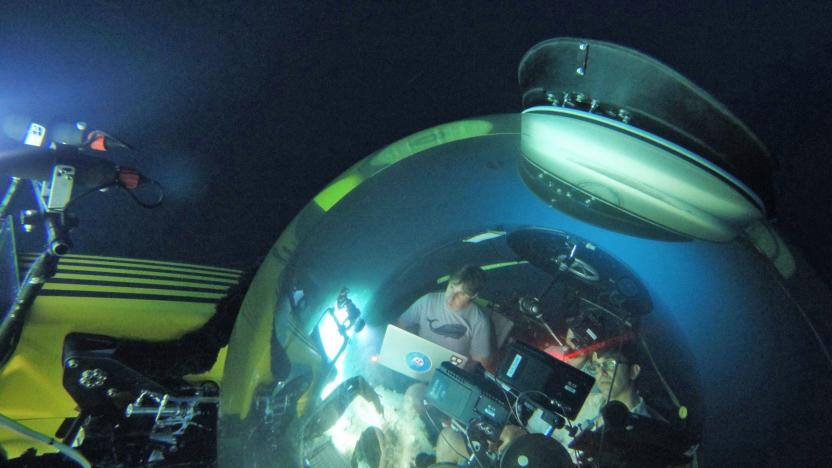
Glove-controlled robot arm is soft enough to pet jellyfish
Remote-controlled robot arms allow submersible operators to perform tasks underwater. But can you imagine a rigid metal limb interacting with something as fragile as jellyfish or corals? To be able to capture or interact with marine life, scientists need something softer that can touch delicate living things without squishing them to death. That's why a team of scientists from Harvard's Wyss Institute has developed a soft robotic arm that can "move with unprecedented dexterity to grasp and sample delicate aquatic life."
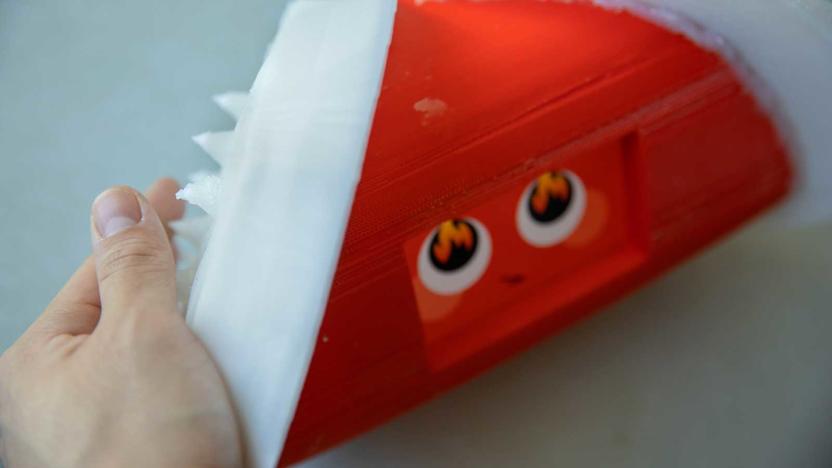
Emotional robot uses goosebumps to show how it's feeling
Sure, a robot can show how it's feeling (insofar as a robot can feel) with its face, but that's not the only way living beings do it. Humans have their goosebumps, for instance, while cats and dogs will raise their fur. Cornell wants to bring that nuance to synthetic beings. Its researchers have crafted a robot that uses a soft, adjustable skin to provide a tactile indication of a robot's emotion -- as the university put it, you can feel its feelings. It may develop goosebumps if it's happy, spikes if it's angry, or just a timid response if it's sad and needs a hug.

Researchers create robotic fish that can swim underwater on its own
Observing fish in their natural ocean habitats goes a long way toward understanding their behaviors and interactions with the surrounding environment. But doing so isn't easy. Using underwater vehicles to get a look at these species is one option, but they often come with a slew of limitations. Some are loud and use propellers or jet-propulsion that disturb fish and their surroundings. And many are designed in a way that doesn't allow them to blend in with the marine environment. Controlling such vehicles is also a challenge and in many cases, they have to be tethered to a boat. But researchers at MIT's Computer Science and Artificial Intelligence Laboratory (CSAIL) have come up with a potential solution -- a soft robot that can swim on its own underwater.
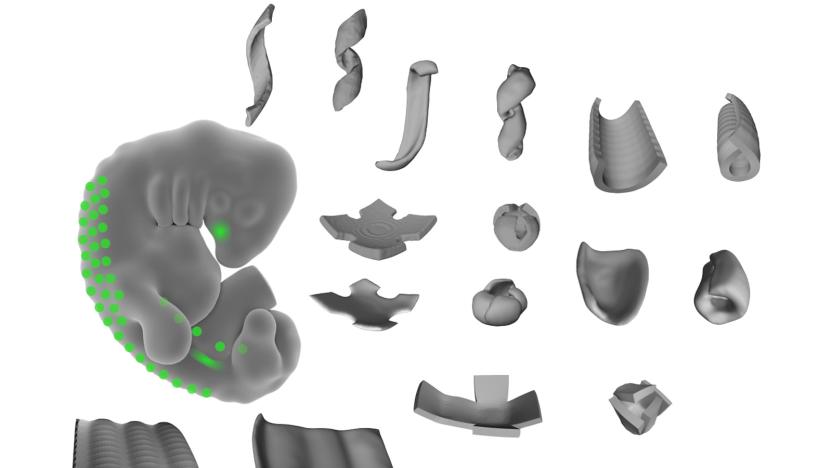
Scientists 'hack' cells to create 3D shapes from live tissue
Never mind 3D-printing organs -- the real dream is to make the tissue itself bend to your will, and UCSF scientists have managed just that. They've discovered that they can 'hack' special cells that help fold tissue (mesenchymal cells) to create 3D shapes out of live tissue. The trick is to lay out these cells in specific patterns that "tug" on other cells' extracellular matrix fibers. You can create surprisingly diverse items, ranging from simple bowls and ripples to decidedly unnatural items like cubes and coils.

Octopus-like rubber skin could lead to shape-shifting robots
Octopuses are awe-inspiring creatures. They're smart, and they can camouflage themselves by changing colors and changing the texture of their skin to mimic the environment's. A group of scientists from Cornell University in New York and the Marine Biological Laboratory in Massachusetts wanted to give soft robots the same ability, so they created a synthetic elastic skin that can morph into different shapes and change textures.
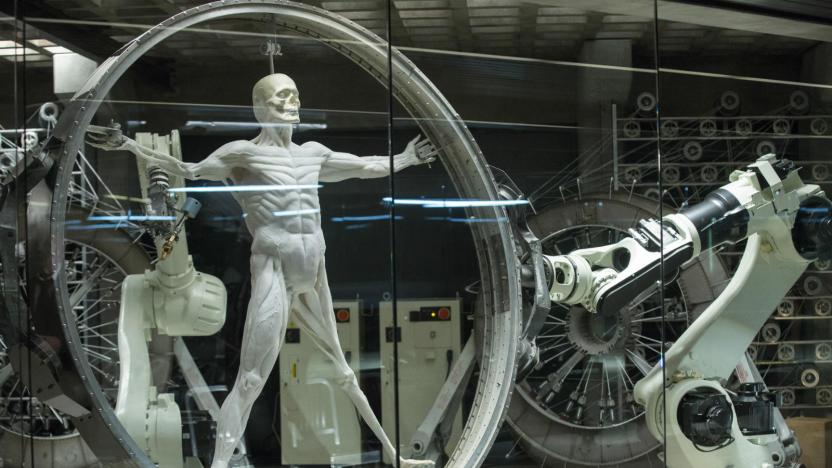
Synthetic muscle breakthrough could lead to 'lifelike' robots
A breakthrough in soft robotics means scientists are now one step closer to creating lifelike machines. Researchers at Columbia Engineering have developed a 3D printed synthetic tissue that can act as active muscle. The material, which can push, pull, bend, and twist (thanks to its use of silicone rubber and ethanol-dispensing micro-bubbles) is also capable of carrying 1,000 times its own weight. Not only could the invention result in super-strong machines (like a Terminator that works in manufacturing), but it will also release soft robots from their current shackles.
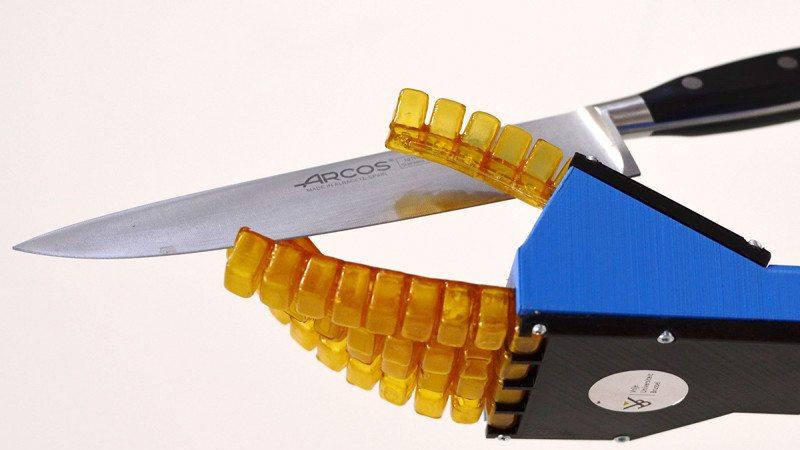
Self-healing polymers make for tougher soft robots
Robotic teams around the world are working on soft robots, because some situations call for a touch gentler than what a rigid machine can give. They can squish into tight locations for search-and-rescue missions, for instance, and pick up fragile objects without breaking or damaging them. Unfortunately, they're also more prone to damage, especially if they're bound to come across sharp edges in their environments. To solve that problem, a team of researchers from Vrije Universiteit Brussel in Belgium have developed a way to create soft machines that can heal themselves -- all you have to do is add heat.
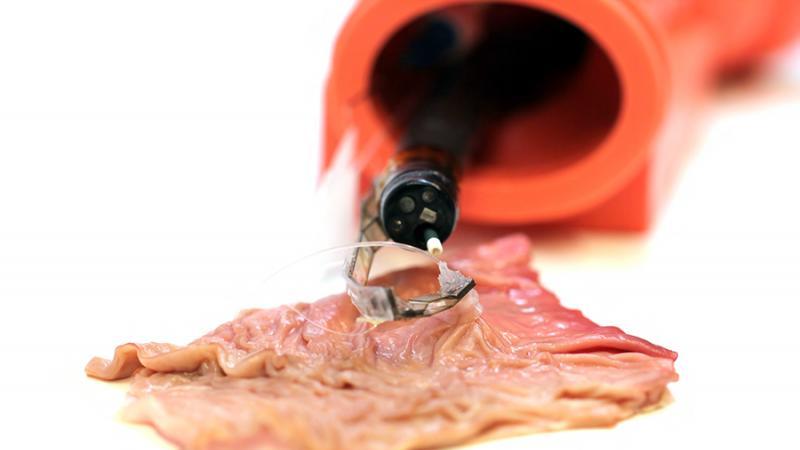
Harvard's tiny robotic arm can make endoscopic surgery safer
Minimally invasive surgery is already amazing as it is, but a team of Harvard scientists have created a device that expands its possible applications even further. They designed a tiny robotic arm that lays flat while the endoscope is moving through narrow passages and pops up to reveal tools surgeons can use for the procedure. Unlike the typical surgical tools doctors use today, which are completely rigid, the team's creation has a hybrid design featuring a rigid skeleton surrounded by soft materials. Even better, it has sensing capabilities that can give the surgeon a sense of where the arm is, what it's touching and how it's moving.

Soft manta ray robot could watch over coral reefs
It looks like Harvard's octopus robot is going to have some stiff competition. Chinese researchers have crafted a soft manta ray-inspired bot that could surveil the seas without harming nature in the process. Rather than rely on stiff metal or plastic for its body, the artificial swimmer is made out of a combination of flexible polymer (for its muscles) and silicone (for most everything else) that shouldn't damage sea life. And importantly, there's no motor -- the ray gets around using a lithium battery whose cyclic voltage causes the muscles to bend, flapping fins in the process. Electromagnets help steer the tail.

Scientists control soft robots with magnetic fields
As slick as soft robots are, they tend to have very simple movements. It'd be a challenge to create a truly complex machine using existing technology. Researchers may have a solution to more sophisticated movement, though. They've invented a technique that uses magnetic fields to steer squishier robots. The trick was to cover the robots in a polymer film loaded with iron microparticles made to form parallel chains using a magnetic field. When you want to steer a robot, you just subject its relevant components to another magnetic field -- the direction and strength of the field determines what happens.
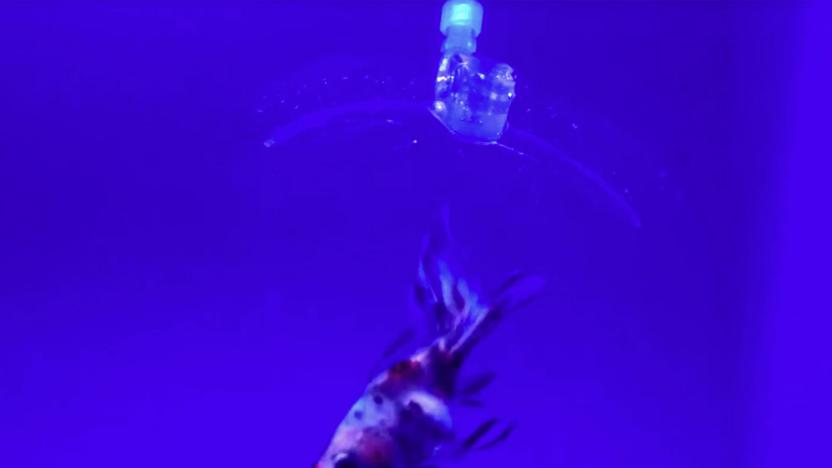
Gel-based robot hand can grab and release fish
Most robot limbs aren't exactly kind to the organic world given all that unforgiving metal, and even rubber-based soft robots aren't very gentle. However, MIT has a better way. It recently built a hydrogel-based soft robot hand that's bio-friendly while remaining tough enough to withstand heavy use. The trick was to use 3D printing and laser cutting to weave hydrogel "recipes" into robotic structures, and pump water into those structures to make them curl or stretch. The results are mostly water-based fingers that still have the strength, durability and speed of more conventional robots.
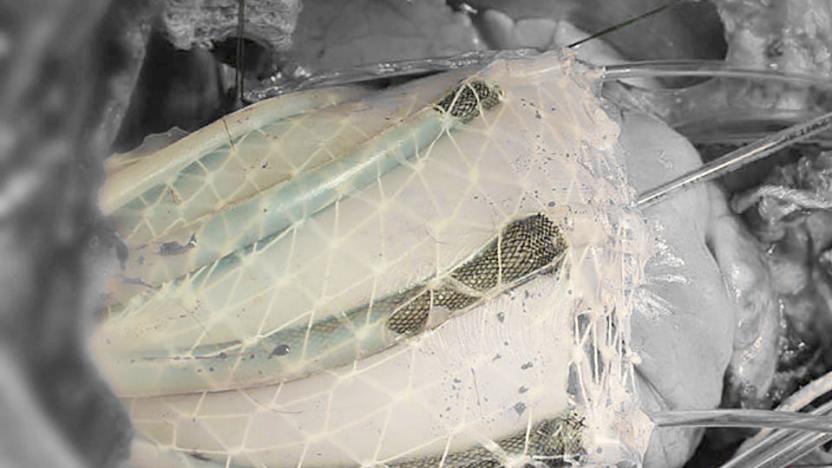
Soft robot wraps around your heart to help it beat
Researchers from Harvard University and Boston Children's Hospital have developed a breakthrough "soft robot" device that might improve your odds of surviving a heart attack. Unlike mechanical devices inserted into heart valves, it's wrapped externally around the heart, where it pumps and twists to assist cardiovascular function. "Most people with heart failure do still have some function left; one day the robotic sleeve may help their heart work well enough that their quality of life can be restored," says co-author and cardiothoracic surgeon Frank Pigula.

MIT's shock-absorbing robots are safer and more precise
Soft robots aren't just about speed and grace... they should be safer, too. To prove that point, MIT's CSAIL has developed bouncing robots whose 3D-printed soft skins act as shock absorbers. The technique revolves around printing a "programmable viscoelastic material" where every aspect of the skin (which includes solids, liquids and a rubber-like substance called TangoBlack+) is tuned to the right level of elasticity. The robot can give way where it needs to, but remain solid otherwise. As a result, it can bounce around without taking damage, and land four times more precisely than it would with an inflexible surface.
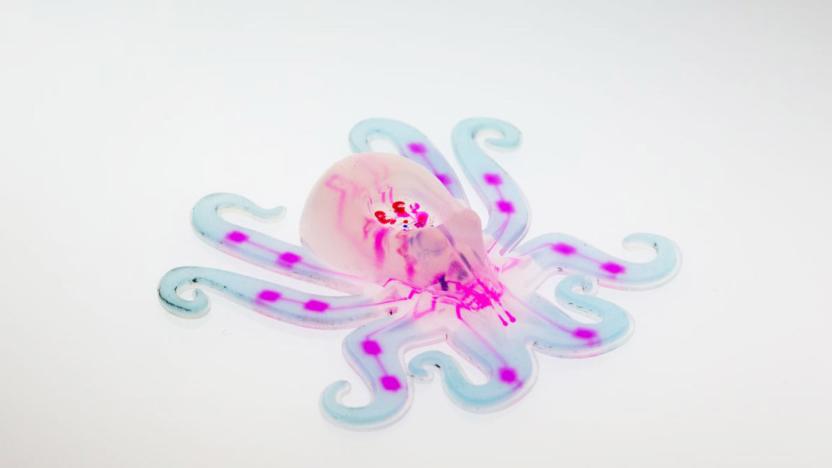
Harvard's Octobot is a soft, fully autonomous robot
See that pretty translucent octopus up there? That's not a toy or a real (but strange) creature from the deep: it's a soft robot developed by a team of Harvard University researchers, and it's completely autonomous. "Octobot's" components, including its fuel storage system, are all 3D printed. But since it's nowhere near the first squishy robot out there -- other Harvard researchers created their own in the past -- what's truly impressive is the system that gives it the ability to move on its own.
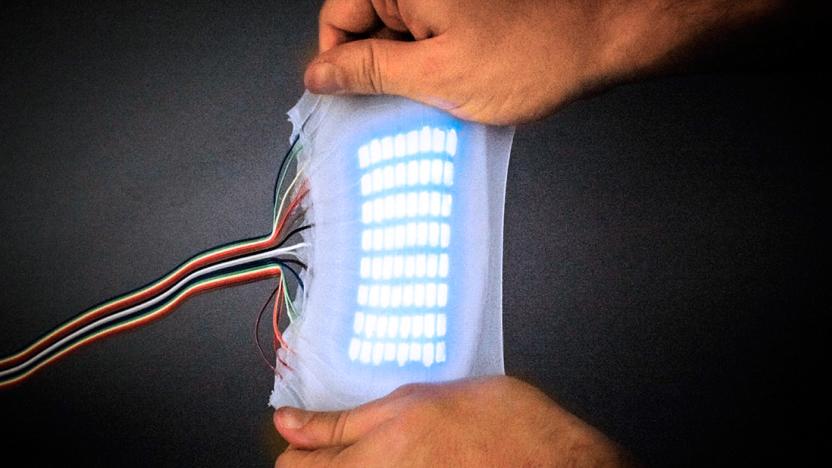
Robots could get soft, stretchable skin that changes colors
Researchers from Cornell University have developed a potential skin material that lights up and stretches to more than six times its original size. The so-called hyper-elastic, light-emitting capacitors (HLECs) are made from transparent hydrogel electrodes wrapped around an insulating dielectric sheet, allowing them to light up when stretched or rolled. Since the skin can handle twice as much strain as earlier materials, it could function as a skin for soft robots that light up to display "emotions."

Tiny pneumatic actuator makes soft robots practical
Soft robots that bend and stretch are cool concepts, but there's usually a lot of clunky hardware involved to make them work, like air compressors and gas generators. They're seldom practical in real life. However, Okayama University researchers have developed a tiny pneumatic actuator that should make those squishy automatons viable. The machinery changes pressure by turning water into hydrogen and oxygen (through a catalyst) in a matter of seconds, and reversing that process about as quickly. All it needs to get going is some electricity -- it doesn't require moving parts or vents, and it's effectively silent.

Scientists make an artificial heart out of foam
Artificial hearts only kinda-sorta behave like the real thing. They pump blood, sure, but they're typically solid blocks of machinery that are out of place in a squishy human body. Cornell University thinks it can do better, though: its scientists have developed an artificial foam heart that imitates both the functions and shape of its fleshy counterpart. The key is a new polymer that can be poured into specific shapes, and has pores that let it pump fluids. It's not only soft and stretchable, but more efficient -- you don't need much energy to get liquids moving.

Liquid metal printing puts flexible circuits on 'anything'
Thanks to top universities and some companies, soft robots and stretchy electronics are already a reality. Now a group of researchers from Purdue claim they've found the right manufacturing process to produce those types of devices en masse. Their method entails printing out circuits using an inkjet printer loaded with liquid metal alloy. "This process... allows us to print flexible and stretchable conductors onto anything, including elastic materials and fabrics," said Rebecca Kramer, one of the researchers. After all, if the circuits are made from liquid metal, they can be stretched, folded, squeezed, and so on and so forth, without breaking.

Soft octopus robots are equal parts speedy and graceful
Soft robotics can go a long way toward recreating the graceful movements of fish and other animals, and it now looks like they're helpful for replicating some of the stranger creatures on our planet, too. A team of Greek researchers has developed an octopus robot that uses silicone tentacles and webbing to move as elegantly as the real thing -- it's convincing enough that small fish will follow along. It's also much faster than a previous attempts, which used stiff plastic to plow through the water. While the original robot moved along at four inches per second, its squishier successor moves along at a healthier seven inches. That's not nearly as quick as the real deal, which can reach 25MPH in bursts, but it's far more consistent with what you'd expect from a real critter this size.

MIT's soft robotic tentacle can squeeze into tight spots (video)
MIT's Computer Science and Artificial Lab (CSAIL) has been developing different types of soft robots for a while: you might remember the mechanical fish from earlier this year that can swim like a real one. Now, that same laboratory has come up with another soft robot, and this time it's inspired by a wriggly, slithery octopus tentacle. CSAIL's robotic "arm" is made entirely out of silicone using 3D-printed molds -- even the "motors" that propel it forward are merely hollow expandable silicone divided into sections. Air is then pumped into the appropriate sections in order for the tentacle to bend, slither and squeeze through.




